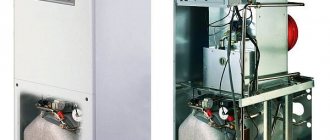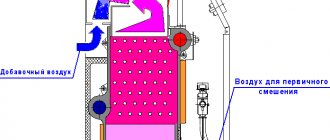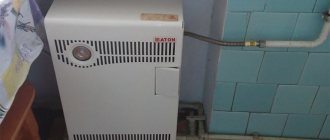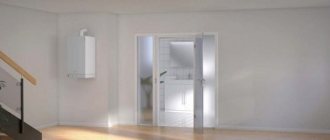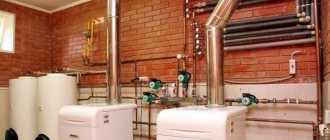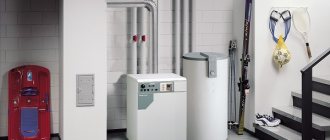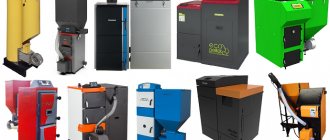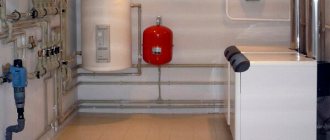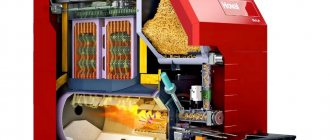For many owners of private homes, choosing a heating boiler is a difficult task.
It is necessary to choose the best option that has the most successful set of functions and characteristics.
This is only possible if you have sufficient knowledge about the design and operating principle of gas boilers, understanding their features and advantages.
There are different types of gas units that have their own characteristics and capabilities.
Let's consider one of the groups of such equipment - parapet boilers.
What is a parapet gas boiler?
Parapet gas boilers are heating units that combine the features of atmospheric and turbocharged models. They are completely energy independent, but are equipped with a closed combustion chamber.
A special feature of this design is the use of a coaxial chimney, which is connected to the rear of the unit and vented to the street. Smoke removal and fresh air intake occur as a result of convection processes.
When the boiler is put into operation, no odors are felt in the room; there are not even traces of soot or other combustion products .
In addition, oxygen does not burn out in the room, which allows you to maintain a normal microclimate.
Another feature of parapet boilers is the ability to be used as independent heating elements. There are special holes in the lower part of the case through which hot air escapes.
It circulates in the room and provides it with the desired temperature.
Advantages and disadvantages of parapet models
The positive features of the equipment are as follows:
- wide scope of application due to the absence of the need for additional structures;
- small dimensions and weight;
- very affordable cost, especially compared to other devices;
- Possibility of use without a heating circuit for one room due to the presence of convection holes in the housing.
The disadvantage of heating with parapet gas boilers is the same as with other heat generators using “blue fuel”: the need to obtain permission from regulatory organizations. It may take several months to agree on all installation details, obtain a positive decision and seal the equipment.
What is the difference from the usual?
The main difference between parapet models and conventional boilers is the ability to obtain increased safety from a non-volatile design and no impact on the internal atmosphere of residential premises.
If a conventional atmospheric boiler consumes ambient air, actively burning oxygen and requiring constant ventilation, then parapet models are completely separate and do not disturb the air exchange regime.
Another difference is the ability to independently heat air, making a parapet boiler similar to a stove.
Why does the boiler blow out in the wind and what to do in this case?
Blowing out may indicate a failure in the connection of the chimney and automation; more often it indicates a lack of wind protection on the head. However, in general, blowing out the burner flame by the wind is a significant and most well-known problem with parapets, which is why they never gained super popularity.
As a rule, the casing of a coaxial chimney, manufactured in a factory, already has a special insert that protects against gusts of wind. If it is not included in the kit, then you will have to look for a suitable deflector or make it yourself: give a sheet of galvanized steel the desired shape, and then attach it to the head with press washers or rivets.
Factory wind protection and an example of a homemade solution by the owners.
When the boiler still goes out after installing the protection, there is no point in doing anything further: you can, of course, continue to install new heads and deflectors, add bends to the coaxial pipe, or install a vertical chimney, but then the whole point of installing a parapet model will be lost.
Advantages and disadvantages
The advantages of parapet boilers include:
- no electricity consumption;
- no internal air is used, there is no additional load on the ventilation system;
- there is no need to connect to a common chimney;
- low fuel consumption;
- efficiency, practicality, resistance to external loads.
The disadvantages of the models can be considered:
- installation requires making a hole in the wall from 25 to 31 cm in diameter;
- installation is only possible near an external wall;
- it is not possible to provide full-function control and protection of units and parts of the unit (for non-volatile models).
Despite the existing disadvantages, parapet boilers are highly rated by users. The demand for them is constantly growing.
How does a boiler work?
Flow movement and names of structural elements.
If non-volatile equipment was purchased, then its operation begins with the piezo ignition button. As a result, the igniter or primary burner of the boiler begins to burn. If the equipment is volatile, that is, equipped with automation, it is put into operation using automation. However, non-volatile models are more common on the domestic market due to their versatility.
The operating principle of a parapet gas boiler is very simple. The pilot light ignites the main burner. Its flame is directed at the heat exchanger through which the heating circuit coolant circulates. The burner operates until the coolant temperature reaches the upper critical level. After this, the automatic heating element is activated. The gas valve is closed. As a result, the gas burner goes out, while the igniter continues to work. As soon as the temperature of the coolant in the heating circuit drops to the lower limit, the gas valve will resume the supply of energy to the burner. The latter will ignite from a working igniter. The water in the heat exchanger will begin to heat up again.
Several structural elements are responsible for the safe operation of the boiler:
- firstly, it is a thermocouple, which is located in the flame of a gas burner;
- secondly, the boilers are equipped with an element to control the presence of draft;
- thirdly, there is a thermostat with a thermometer.
Are you buying a parapet gas boiler? The instruction is the document on which the choice should be based. The instructions contain information regarding the power of the device, the rules for its installation and operation.
The thermocouple generates a low voltage electric current from the heat of the burner. It feeds the gas valve and keeps it open. If the flame inside the boiler goes out for some reason, the thermocouple stops producing electric current. The valve closes automatically. The gas supply stops.
Sectional view of a wall-mounted parapet gas boiler (rear view).
If there is no draft in the boiler, then the main structural element of the safety device (plate) increases its temperature to +65°C. The signal from it goes to the gas supply valve. The latter closes and the gas burner stops working. A similar mechanism is typical for a non-volatile boiler. If the equipment is connected to the electrical network, then the traction control is controlled automatically.
A thermostat with a thermometer protects the boiler from overheating. As soon as the thermometer detects a critically high temperature of the coolant in the heating circuit, it transmits a signal to the thermostat. The latter also stops the gas supply to the gas burner.
The wall-mounted parapet gas boiler at one time was a worthy competitor to conventional wall-mounted heating elements, despite their versatility. Thus, the latter were very demanding about the gas pressure in the gas pipeline, scale often formed on their heat exchanger, and they required uninterrupted power supply. Parapet devices are not so demanding on the pressure in the gas pipeline. Non-volatile models do not require power. Their coaxial chimney can be mounted both vertically and horizontally, which expands the possibilities of their installation.
Why does the installation of chimneys for boilers play a vital role when assembling a heating circuit?
What are the options for chimneys for gas boilers? The answer is here.
Device
The design of the parapet unit almost completely replicates the design of any non-volatile boiler.
The coolant enters the primary (main) heat exchanger, where it receives a high temperature and enters a three-way valve (mixing unit). In it, colder “return” is mixed into the hot liquid, as a result of which the temperature of the heating agent takes on the parameters specified by the mode.
In double-circuit models, before entering the three-way tap, the coolant passes through a secondary heat exchanger, where DHW is prepared.
The difference lies in the structure of the combustion chamber and chimney, which are not typical for such devices . To exhaust smoke, a coaxial double pipe is used, through the outer cavity of which fresh air enters, and the inner cavity is a chimney.
Air is sucked into the closed combustion chamber and ensures the combustion process. When heated, it expands and displaces smoke and other gases produced when fuel is burned. Some models are equipped with two separate pipes, one of which supplies air and the other exhausts smoke.
This option allows you to enhance convection and stabilize the processes of gas movement.
Single and Dual Circuit Devices
Parapet boilers are produced in a standard rectangular shape, single- and double-circuit, left- and right-handed, which makes their installation easy and convenient.
Single-circuit ones are intended only for heating. They are equipped with a plate heat exchanger, which ensures the rate of heat exchange between the gas burner flame and the coolant.
The double-circuit parapet boiler has an additional copper coil, which provides the house with hot water supply. Water is heated only by flow. If you use a storage tank, the size of the equipment will increase significantly, which will make it impossible to install it in an ordinary apartment.
Kinds
There are different design options for parapet boilers, which can be divided according to specific characteristics.
By installation method:
- wall-mounted Installed in a hinged manner on an external (load-bearing) wall. According to installation conditions, weight and power are limited;
- floor Installed on the floor. If it is wooden, a non-flammable stand is required. There are no restrictions on weight, dimensions and power.
By power supply method:
- volatile. The design contains components that require the use of electricity - a circulation pump. electronic control board, etc.;
- non-volatile. They work only with mechanical control. A good choice for remote villages and areas with intermittent power supplies.
By feature set:
- single-circuit. Capable only of providing heating of the coolant;
- double-circuit. In parallel with heating, the heating agents are capable of preparing hot water for domestic needs.
NOTE!
Most users prefer single-circuit floor-standing models, which demonstrate the greatest efficiency.
How to choose and what to pay attention to?
When choosing a parapet gas boiler, the buyer should pay attention to a number of related factors.
Initially, you should start from the future location of the device and its technical characteristics. Depending on the space occupied by equipment in homes, there are floor-standing and wall-mounted boilers.
Accordingly, the buyer should focus on the type that is most convenient for him.
An important parameter is also the power characteristic . Gas boilers are divided into two types - single-circuit and double-circuit.
The latter combine two functions at once - space heating and water heating.
Single-circuit ones have the advantage of random switching off and turning on.
If the choice falls on double-circuit boilers, you should pay attention to models with increased power, since the device’s energy reserve is additionally spent on heating water.
You should also carefully choose the appropriate thickness of the walls of the heat exchanger of the boiler you are purchasing, on which the operating life of the unit depends.
However, it is worth remembering that for boilers with walls made of steel whose thickness exceeds 3 mm, efficiency decreases significantly.
Principle of operation
The operation of a parapet boiler differs little from the usual operation of gas convection units.
The burner heats the coolant, which transfers part of the energy to prepare DHW or is discharged into the heating circuit after preparation in a three-way valve.
There are no changes in this. A specific feature is the ability of the boiler to perform the function of a convector, which makes it possible not to install radiators in the room where the unit is located.
In addition, a special method of air supply and smoke exhaust is used. When the burner is ignited, excess air pressure arises in the upper part of the combustion chamber, causing it to be expelled along with the smoke outside.
At the same time, a vacuum is formed in the lower part, creating a suction of fresh flow through the outer part of the coaxial pipe. A pressure difference arises similar to that used in conventional ovens.
This allows the use of a closed combustion chamber without a turbo fan.
IMPORTANT!
In some designs, the chimney and air intake pipe are made separately, but this does not change the principle of operation.
Rules and installation locations
Equipment of this type is used in rooms where a traditional chimney is not provided. A parapet gas boiler can be installed anywhere in the house thanks to a closed combustion chamber and a coaxial chimney, but the main condition is its location near the wall. This ensures that the coaxial pipe is brought out to the street.
A coaxial chimney is a stainless steel structure consisting of two pipes of different diameters located one inside the other. Thanks to this design, a space is provided through which air mass flows to ensure gas combustion. Combustion products are removed through a pipe of smaller diameter. The coaxial chimney is directed through the wall to the street, and wind protection must be installed. After this, the installation of flue pipes, heating circuits and hot water supply is carried out.
Installing the equipment is quite simple, but doing it yourself is strictly prohibited. You should contact licensed specialists. Connection to the gas main is made exclusively by gas service employees.
This is important: what standards exist for installing heating boilers in a private home.
Rating of TOP 5 parapet gas boilers
Parapet boilers do not have many of the disadvantages of wall-mounted models, so their range is constantly increasing.
Let's look at the most popular models:
Lemax Patriot-12.5
Floor-standing, non-volatile parapet boiler of domestic production. The power of the unit is 12.5 kW . This is suitable for rooms up to 125 square meters. m.
Main characteristics of the unit:
- Efficiency - 87%;
- coolant temperature - 80°;
- system pressure - up to 2 bar;
- gas consumption - 0.75 m3/hour;
- dimensions - 595x740x360 mm;
- weight - 50 kg.
The boiler is single-circuit, but it is possible to connect an external boiler. This will allow you to get a full-fledged hot water supply line.
Lemax Patriot-20
Floor-mounted parapet boiler produced by the Taganrog plant. The power of the unit is 20 kW, so the size of the room should not exceed 200 sq. m. m .
Only the basic task is performed - heating the coolant. If you need to expand the functionality, you should purchase and connect an external storage boiler.
Boiler parameters:
- Efficiency - 87%;
- coolant temperature - 80°;
- system pressure - up to 2 bar;
- gas consumption - 1.2 m3/hour;
- dimensions - 670x790x400 mm;
- weight - 67 kg.
Users and experts note low fuel consumption, which increases the efficiency of the unit and allows for significant savings.
Lemax Patriot-16
Another example of domestic heating technology. Parapet floor-standing boiler with a power of 16 kW , intended for use in rooms up to 160 sq. m.
Like other models of the Patriot series, this is a single-circuit unit with a steel heat exchanger.
Its characteristics:
- Efficiency - 87%;
- coolant temperature - 80°;
- system pressure - up to 2 bar;
- gas consumption - 0.95 m3/hour;
- dimensions - 670x790x400 mm;
- weight - 67 kg.
The Patriot series units with a power of 16 and 20 kW are the same design, only one of the models has artificially reduced performance.
Lemax Patriot-10
A product of engineers from Taganrog. A 10 kW parapet boiler is suitable for a country house or private house with an area of up to 100 square meters. m .
- Efficiency - 87%;
- coolant temperature - 80°;
- system pressure - up to Bar;
- gas consumption - 0.6 m3/hour;
- dimensions - 595x740x360 mm;
- weight - 50 kg.
NOTE!
Reliability and low fuel consumption make Lemax Patriot parapet boilers the best choice for all users.
ATON Compact 12.5E
Gas parapet boiler made in Ukraine. The power of the model is 12.5 kW, and the service area is up to 160 sq. m. Non-volatile unit designed for floor mounting.
Main parameters of the boiler:
- Efficiency - 90%;
- coolant temperature - 90°;
- system pressure - up to 1.5 Bar;
- gas consumption - 1.39 m3/hour;
- dimensions - 630x700x275 mm;
- weight - 50 kg.
The unit is equipped with a stainless steel heat exchanger and has a gas safety valve.
Advantages and features of parapet units
The main advantage of the equipment is its compactness: a parapet boiler running on gas can easily fit in the kitchen under a window sill or in any other room, since during operation it does not consume oxygen from the room and does not pose a danger to residents. A coaxial chimney is a reliable and safe smoke removal system, which also offers a choice in favor of such equipment.
The correct choice of product should be based on the following parameters (except for consumer reviews and catalogs from selling companies):
- Installation technology: the parapet boiler is made for mounting on walls and floors; there are also left- and right-hand models;
- A gas parapet boiler can be equipped with one or two circuits. One circuit is for heating only, the second circuit is for domestic hot water;
- Also, parapet boilers can be energy-dependent (with an automatic monitoring, adjustment and control system) and non-volatile (with or without manual adjustment).
Technical characteristics of universal boilers
The thermal power possessed by parapet boilers varies between 15 kW-40 kW for a unit with one circuit. If you choose to install parapet equipment with two water heating circuits, then the capacity for heating water for domestic needs should also be added to the rated power. For example, parapet boilers with a power of 12 kW -15 kW easily heat the volume of water up to 180 l/h, which, according to the standards, is four water points (faucets, toilets, faucets, showers, etc.).
- The single-circuit unit has a standard heat exchanger (jacket) of a plate design, which speeds up the process of heat exchange between the gas burner and the working fluid of the heating system. The material of the shirt is thick 3 mm steel.
- Double-circuit gas parapet boilers contain, in addition to the heat exchanger, a copper or brass coil for hot water supply, in which water is heated only by the flow method. If you increase the productivity of the hot water supply due to an additional hot water tank, then such a boiler will no longer be able to be installed in the kitchen.
Also, in addition to wall-mounted and floor-mounted models, there are products with differences in installation: with left-side connection of the gas pipe, hot water supply and heating circuit, and with right-side connection. This convenience should not be overlooked when choosing a boiler for an apartment or house. The dimensions of the unit are determined by its performance and the number of water heating circuits. For example, if a boiler has one circuit, then its dimensions will be smaller than that of a double-circuit one.
Types of boilers by power
Prices: summary table
Comparative rating of boilers consuming liquefied fuel :
| Boiler model name | Efficiency, % | power, kWt | LPG consumption, l/h | price, rub. |
| Protherm Gepard 23 MOV | 90 | 23 | ≤ 1,9 | 51 000 |
| Bosch Gaz WBN6000-24C RN | 92 | 24 | ≤ 1,5 | 38 500 |
| Buderus Logamax U072-18K | 92 | 18 | ≤ 1,5 | 39 500 |
| BAXI SLIM 1.150 I | 90 | 15 | ≤ 1,1 | 78 000 |
| Wester Lemax Clever-30 | 90 | 30 | ≤ 1,7 | 51 000 |
